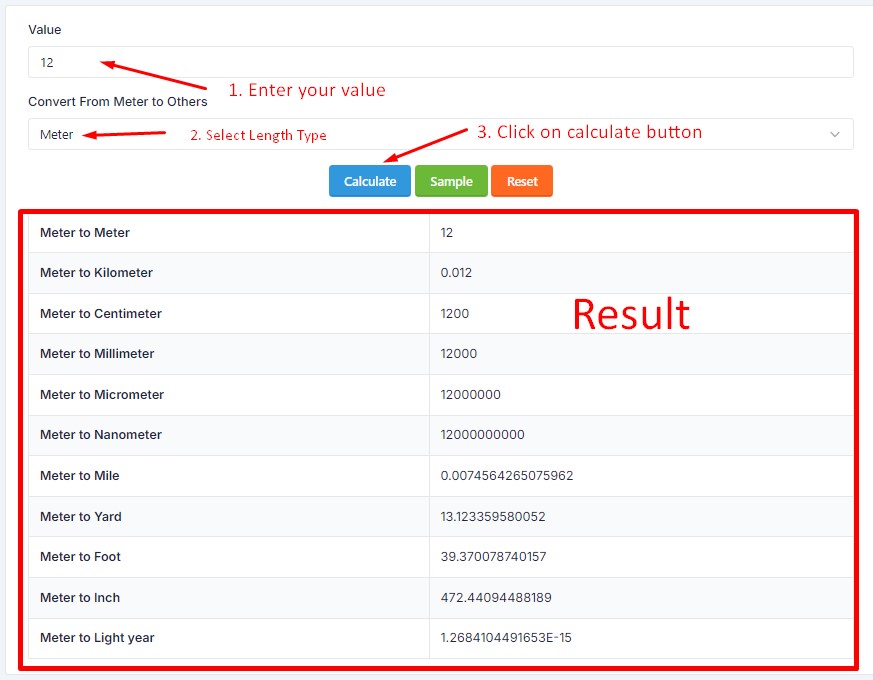
Length Converter
Convert a measurement of length from one unit to another
A length converter is a tool that helps convert a measurement of length from one unit to another.
The tool is essential in various fields, including engineering, construction, science, and daily life, as length measurements are fundamental in a wide array of applications.
With many units of length in existence (e.g., meters, feet, inches, kilometers, miles), the length converter provides an efficient way to switch between them seamlessly.
Table of Contents
What is a Length Converter?
A length converter is a calculator that converts one unit of length into another. It allows the conversion of different units such as meters to feet, inches to centimeters, miles to kilometers, and so on. The tool can be either digital (like an online converter or mobile app) or manual (using conversion charts or mathematical formulas). Modern length converters are generally digital because they can quickly and accurately perform conversions in a matter of seconds.
Why Use a Length Converter?
Length converters are widely used because:
- Precision: They ensure accurate conversions between various units, which is crucial for tasks that require exact measurements.
- Convenience: They save time and reduce manual calculation errors, making it easier for people who work in fields that involve length measurement.
- Efficiency: With quick conversions, they improve productivity in projects such as construction or scientific research where different units may be used interchangeably.
- Global Standardization: As different regions use different measurement systems (e.g., the metric system vs. the imperial system), a length converter helps standardize the units, making communication and collaboration more straightforward.
Advantages of Length Converters
Accuracy and Precision
- Mathematical Accuracy: Length converters provide high levels of accuracy. This is essential in fields such as engineering and science, where even small errors can significantly impact the outcome.
- Standardization: They allow users to standardize units across different measurement systems, ensuring consistency in documentation and communication.
Convenience
- Time-Saving: Instead of manually calculating conversions, users can instantly get results using a length converter.
- User-Friendly Interfaces: Most online length converters have straightforward interfaces, making them easy to use even for beginners.
- Accessibility: Many length converters are available as free online tools or mobile apps, making them accessible to anyone with an internet connection or smartphone.
Versatility
- Multiple Units Supported: Length converters support numerous units, including meters, feet, inches, miles, kilometers, centimeters, millimeters, nautical miles, yards, and more.
- Custom Conversions: They often allow users to perform less common conversions, such as astronomical units or light years.
Error Reduction
- Reduced Human Error: Since the conversion is handled by the tool, the risk of calculation mistakes is minimized.
- Easy Validation: Users can quickly check and validate conversions to ensure they meet the required standards.
Disadvantages of Length Converters
Dependency on Technology
- Internet Dependency: If the length converter is online, it requires an internet connection. In offline scenarios, users may be unable to access the tool.
- Device Compatibility Issues: Some converters may not work on all devices, especially if they rely on specific software or browser capabilities.
Lack of Understanding of Manual Conversion
- Over-Reliance on Tools: Frequent use of digital length converters can lead to reduced understanding of manual conversion processes and formulas.
- Learning Gap: In situations where a digital converter is not available, people may struggle with manual conversions if they are not familiar with the process.
Limited Accuracy in Some Tools
- Rounding Errors: While most high-quality converters provide accurate results, some may round off values too early, causing slight inaccuracies in conversions.
- Outdated Tools: Older or less sophisticated converters may not have updated unit standards or formulas, leading to potential discrepancies.
How to Use a Length Converter
Using the Saima Length Converter is straightforward, especially when using digital tools. Here’s a step-by-step guide on how to use them:

Step 1: Enter the Length Value
Input the length value you wish to convert. For instance, if you want to convert 100 centimeters to meters, you would enter "100" in the value field.
Step 2: Select the Input Unit
Start by selecting the unit of the length that you currently have. This could be any unit, such as meters, feet, or inches. The length converter will usually have a dropdown menu from which you can choose the input unit.
Step 3: Get the Result
Once the input and output units are selected and the value is entered, click the "Convert" button to view the automatically generated result. The converter will show the equivalent value in the desired unit.
Step 5: Repeat (Optional)
If you need to perform multiple conversions, simply adjust the input values or units accordingly.
Types of Length Conversions
The conversions performed by length converters can be classified based on the systems of measurement:
Metric to Imperial Conversions
These involve converting between metric units (like meters and kilometers) and imperial units (like feet and miles). Examples include:
- Meters to Feet: 1 meter is approximately 3.28084 feet.
- Kilometers to Miles: 1 kilometer is approximately 0.621371 miles.
Imperial to Metric Conversions
These involve converting from imperial units to metric units. For example:
- Inches to Centimeters: 1 inch equals 2.54 centimeters.
- Miles to Kilometers: 1 mile is approximately 1.60934 kilometers.
Conversions Within the Same System
These conversions occur between different units within the same measurement system. For example:
- Centimeters to Meters: 100 centimeters equals 1 meter.
- Feet to Inches: 1 foot equals 12 inches.
Applications of Length Converters
Length converters find applications in various fields:
Construction
- Architects and Builders: Often work with measurements in different units, such as feet for construction drawings and meters for material estimates.
- Surveyors: Use length converters to accurately measure land or structures.
Engineering
- Mechanical Engineering: Engineers often need to convert units when working with international standards.
- Electrical Engineering: Wire lengths may be measured in different units depending on the country or standards being used.
Science and Education
- Physics and Chemistry: Scientists often perform calculations involving units of length for experiments and theories.
- Educational Tools: Length converters help students understand conversions between different measurement systems.
Daily Life
- Travel: Converting distances between miles and kilometers.
- Sports: Measuring running distances in different units, such as meters versus yards.
FAQs About Length Converters
What is the Difference Between Metric and Imperial Systems?
The metric system is a decimal-based system of measurement, used worldwide, with common units such as meters, centimeters, and kilometers. The imperial system, used mainly in the United States and the United Kingdom, uses units such as feet, inches, and miles. Length converters can easily convert measurements between these two systems.
Are Online Length Converters Accurate?
Yes, reputable online length converters provide accurate results. However, it's always good to double-check conversions, especially if using an unfamiliar or low-quality tool. High-quality converters use standard conversion factors and are regularly updated for accuracy.
Can I Use a Length Converter Offline?
Yes, if you download a length converter app or use a tool that has offline functionality. There are also manual methods, such as using conversion tables or performing calculations with known conversion factors.
How Do I Convert Between Uncommon Units Like Nautical Miles?
Length converters often support a wide range of units, including nautical miles, light-years, and astronomical units. For example, 1 nautical mile equals approximately 1.852 kilometers.
Why Are There So Many Different Length Units?
The different length units evolved over time based on regional practices, cultures, and applications. For example, the imperial system has historical roots in the British Empire, while the metric system was designed for global standardization in science and trade.
Can Length Converters Handle Decimal Places?
Yes, most digital length converters allow for decimal input, providing precise results for fractional measurements. You can input values like 2.54 meters or 3.7 inches, and the tool will give an accurate conversion.
Manual Conversion Formulas
Although length converters are convenient, knowing the formulas for manual conversion can be helpful:
Metric to Imperial
- Meters to Feet: Multiply the number of meters by 3.28084.
- Kilometers to Miles: Multiply the number of kilometers by 0.621371.
Imperial to Metric
- Inches to Centimeters: Multiply the number of inches by 2.54.
- Miles to Kilometers: Multiply the number of miles by 1.60934.
Same-System Conversions
- Centimeters to Meters: Divide the number of centimeters by 100.
- Feet to Inches: Multiply the number of feet by 12.
Conclusion
Length converters are essential tools for anyone who deals with measurements regularly. They provide accuracy, save time, and improve productivity across various















